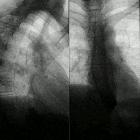gastric antral vascular ectasia
Gastric antral vascular ectasia (GAVE), also known as watermelon stomach, is a rare condition affecting the stomach. It is one of the diagnoses to consider in older patients with severe anemia and occult or profuse gastrointestinal bleeding (especially in those with cardiac, liver, or renal diseases).
It can be a significant cause of severe acute or chronic gastrointestinal blood loss in the elderly.
Epidemiology
While it is rare, it may account for up to 4% of non-variceal upper gastrointestinal blood loss.
Pathology
Its pathogenesis is unknown although it is associated with heterogeneous conditions, including various hepatic, renal , and cardiac diseases.
Pathognomonic red vascular folds (which have been likened to stripes on a watermelon) may be seen on endoscopic evaluation. A histologic hallmark is the presence of superficial fibromuscular hyperplasia of gastric antral mucosa with capillary ectasia and microvascular thrombosis in the lamina propria.
Radiographic features
Findings include
- prominent, scalloped antral folds radiating to the pylorus
- thickening of the gastric antrum.
History and etymology
It was first described by J A Rider et al. in 1953 .
See also
Siehe auch:

 Assoziationen und Differentialdiagnosen zu Wassermelonenmagen:
Assoziationen und Differentialdiagnosen zu Wassermelonenmagen:



